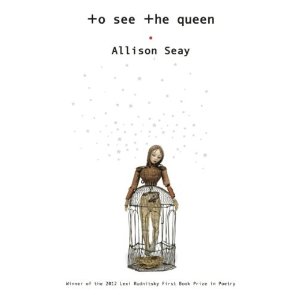 Winner of the 2012 Lexi Rudnitsky First Book Prize in Poetry, To See the Queen is Allison Seay’s stunning, haunting debut poetry collection that recollects a woman’s journey through the alternative world of depression. The collection contains four sections, each capturing some facet from the speaker’s childhood, abusive marriage, and struggle to find happiness in a world haunted by her “figment,” Lilianna. Lilianna’s presence makes itself known from the very beginning, with the collection’s first chilling poem “The Figment.” The figment, Lilianna, is described as one who “vanishes” and returns in many forms—“just as God does.” In this poem and throughout the collection, Lilianna serves as a spirit like manifestation of the speaker’s intense grief; she floats, a broken off piece of what used to be a whole woman, one to whom the speaker can tell about “sadness,” while she thinks about “one way of living: slipping off / into some indistinguishable state / of more and more snow.”
Winner of the 2012 Lexi Rudnitsky First Book Prize in Poetry, To See the Queen is Allison Seay’s stunning, haunting debut poetry collection that recollects a woman’s journey through the alternative world of depression. The collection contains four sections, each capturing some facet from the speaker’s childhood, abusive marriage, and struggle to find happiness in a world haunted by her “figment,” Lilianna. Lilianna’s presence makes itself known from the very beginning, with the collection’s first chilling poem “The Figment.” The figment, Lilianna, is described as one who “vanishes” and returns in many forms—“just as God does.” In this poem and throughout the collection, Lilianna serves as a spirit like manifestation of the speaker’s intense grief; she floats, a broken off piece of what used to be a whole woman, one to whom the speaker can tell about “sadness,” while she thinks about “one way of living: slipping off / into some indistinguishable state / of more and more snow.”
With this introduction, Seay provides the template for the rest of the collection: a journey through the cold, seemingly endless world in which the lines between past and present, reality and imagination, and right and wrong are crossed and blurred. In To See the Queen, Seay’s striking line breaks and calm, salient images to make each poem resonate, gong-like. And Lilianna hovers in the sound waves. While each poem differs in content, Seay deftly weaves motifs of space, elements, and love, all the while questioning what it truly means to “see.”
In a later poem, “Room of the Curved Spines,” the speaker speculates on the dangerous nature of bad habits and bad influence as she recalls a moment in a middle-school bathroom, where “the girls / stood in line as a string of beads / and one by one we removed our blouses…vertebra by vertebra we were inspected like pearls.” The poem offers a sinister picture of anorexia contrasted with the youthful perception of beauty like “pearls,” noting, “Before long, things become permanent.”
The collection has the unique effect of capturing a myriad of compelling moments and cataloguing them into one book that seems to relay not just a narrative, but also a journey. Seay’s deeply personal voice sings a sad yet wrenchingly powerful song from poem to poem, and you cannot help but nod along empathetically as you turn each careful page. Seay draws you into her town (another compelling metaphor throughout the collection), and you find yourself sinking with her, chilled when she is chilled, questioning the abusive nature of God and man and then finding solace in an ultimate recovery—all the while, feeling Lilianna’s silent presence in the background. To See the Queen is a striking addition to contemporary poetry. Seay strikes the perfect balance between the sacrament of the mundane and the heart of the human conflict. She sings out to that need to imagine and mourn, that ache to find comfort and visualize hope.
